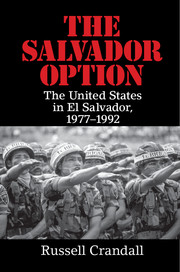Book contents
- Frontmatter
- Dedication
- Epigraph
- Contents
- List of Figures
- List of Organizations
- Acknowledgments
- 1 Introduction
- PART ONE EL SALVADOR IN THE COLD WAR
- PART TWO JIMMY CARTER
- 7 Revolution and Counterinsurgency in Guatemala
- 8 Mass Organizations
- 9 Carter Arrives
- 10 Carter and the Sandinista Revolution in Nicaragua, 1979
- 11 An October Coup
- 12 Carter Engages Salvador
- 13 Archbishop Romero
- 14 Land
- 15 The American Churchwomen
- 16 Arming the Rebels
- 17 Guerrilla Final Offensive, January 1981
- 18 Death Squads
- PART THREE RONALD REAGAN
- PART FOUR GEORGE H. W. BUSH
- PART FIVE POSTWAR
- Notes
- Bibliography
- Index
11 - An October Coup
from PART TWO - JIMMY CARTER
Published online by Cambridge University Press: 05 June 2016
- Frontmatter
- Dedication
- Epigraph
- Contents
- List of Figures
- List of Organizations
- Acknowledgments
- 1 Introduction
- PART ONE EL SALVADOR IN THE COLD WAR
- PART TWO JIMMY CARTER
- 7 Revolution and Counterinsurgency in Guatemala
- 8 Mass Organizations
- 9 Carter Arrives
- 10 Carter and the Sandinista Revolution in Nicaragua, 1979
- 11 An October Coup
- 12 Carter Engages Salvador
- 13 Archbishop Romero
- 14 Land
- 15 The American Churchwomen
- 16 Arming the Rebels
- 17 Guerrilla Final Offensive, January 1981
- 18 Death Squads
- PART THREE RONALD REAGAN
- PART FOUR GEORGE H. W. BUSH
- PART FIVE POSTWAR
- Notes
- Bibliography
- Index
Summary
We don't want to be in the business of endorsing coups, but we are in the business of facing reality.
– U.S. diplomat, October 1979This government is having a difficult birth. But the alternative is collective suicide.
– Civilian member of Revolutionary Government Junta of El Salvador, November 1979Black September
In May 1979, a small number of Salvadoran officers began to meet secretly to discuss pressing matters. They saw a growing internal leftist revolutionary movement that not only was raising large sums of money from kidnapping wealthy Salvadorans or foreign businessmen but also could put 200,000 demonstrators in the streets at one time via the allied mass organizations. They also looked at Nicaragua, where the Somoza dynasty was in its death throes, and saw the Carter administration was not rescuing the Nicaraguan National Guard, a rough equivalent to their own armed forces. They also believed that ruling strongman General Romero was fatally isolated from senior army officers as well as out of favor with the Carter administration because of what an American journalist called the “growing number of bodies turning up in trash cans and along the roads.” These officers soberly concluded that the Marxist-Leninist guerrillas and their supporting organizations could overthrow the Romero regime by the end of the year, so they decided to act before this “nightmare became a reality.”
Writing for the U.S. magazine Newsweek in late September 1979, journalists Steven Strasser and Stryker McGuire provided a sense of El Salvador's dire situation. The country had marked its independence day only a week before, but there “was little to celebrate” due to the widespread violence and fear. Leftist opponents of the General Romero dictatorship promised that the month would be “Black September,” during which the agitation against the regime would swell. This is some of what journalists reported:
The air of confrontation in El Salvador is the thickest since last spring, when 19 demonstrators were killed by police during a sit in at a San Salvador cathedral. In this month's boldest attack from the left, two gunmen barged into the home of the President's brother, retired professor José Javier Romero, and murdered him as he watched television.
- Type
- Chapter
- Information
- The Salvador OptionThe United States in El Salvador, 1977–1992, pp. 122 - 131Publisher: Cambridge University PressPrint publication year: 2016

